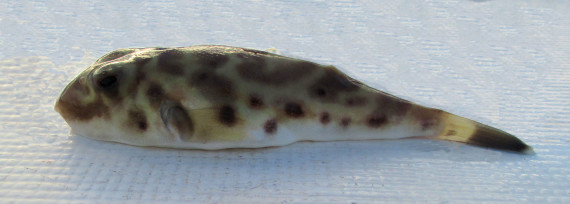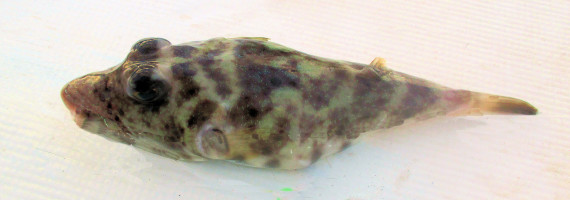Peruvian Puffer, Sphoeroides sechurae
 Peruvian Puffer, Sphoeroides sechurae. Fish caught from coastal waters off Loreto, Baja California Sur, October 2015. Length: 15 cm (5.9 inches). Catch, photograph and identification courtesy of George Brinkman, Guelph, Ontario, Canada.
Peruvian Puffer, Sphoeroides sechurae. Fish caught from coastal waters off Loreto, Baja California Sur, October 2015. Length: 15 cm (5.9 inches). Catch, photograph and identification courtesy of George Brinkman, Guelph, Ontario, Canada.
The Peruvian Puffer, Sphoeroides sechurae, is a member of the Puffer or Tetraodontidae Family, and is known in Mexico as botete peruano or simply just botete. Globally, there are twenty-three species in the genus Sphoeroides, of which thirteen are found in Mexican waters, eight in the Atlantic Ocean and five in the Pacific Ocean.
The Peruvian Puffer has a thick oblong inflatable body. They are dark olive brown dorsally and transition to off-white ventrally. They have dark spots above their eyes and scattered along their flank behind their pectoral fins. They have indistinct pale lines: one located between the front borders of their eyes, another between the rear borders of their eyes, and a third one angling down along their back above their pectoral fins and joining a short line from the dorsal origin. They have an indistinct pale oval on the center of their back. Their anal and pectoral fins are transparent with a narrow dark bar at their base. The inner third of their caudal fin is olive brown and the outer two-thirds is black with a clear margin. Their dorsal fin has a dark base. Their head is relatively long and slender with a wide flat section between the eyes, which are set high on the sides of the head. They have strong beaks composed of 4 fused teeth. Their anal fin has a short base with 7 or 8 rays that is located slightly behind the similarly shaped dorsal fin, which has 7 or 8 ray, found toward the rear of the body; and their caudal fin is straight or convex with 10 rays and they do not have pelvic fins. Their fins have no spines. They have no scales but are covered with spines and lack skin flaps.
The Peruvian Puffer is found over sandy and muddy bottoms at depths up to 152 m (385 feet). They reach a maximum of 17.0 cm (6.7 inches) in length. They are exceedingly well camouflaged and have the ability to blow themselves up like balloons, presumably as a defense mechanism to deter predator attacks. The Peruvian Puffer is an exceeding rare and is poorly studied with very limited information available about their lifestyle and behavioral patterns including specific details on age, growth, longevity, movement patterns, diet, habitat use, and reproduction.
The Peruvian Puffer is a resident of all waters of the Pacific Ocean with the exception that they are absent from the entire west coast of Baja.
The Peruvian Puffer is easily confused with the Longnose Puffer, Sphoeroides lobatus (small light blue spots on head without prominent barring) and the Naked Puffer, Sphoeroides lispus (no spotting on sides).
From a conservation perspective the Peruvian Puffer is currently considered to be of Least Concern with stable, widely distributed populations. They are an uncommon infrequent by-catch via hook and line. When encountered they are small in stature and of limited interest to most. Note: Like many Puffers, the Peruvian Puffer is reputed to be highly poisonous, even fatal, if eaten, due to the potential presence of the potent neurotoxins saxitoxin and/or tetrodotoxin, which is found in their skin, viscera, and gonads and is believed to protect them from predation by larger fish.
